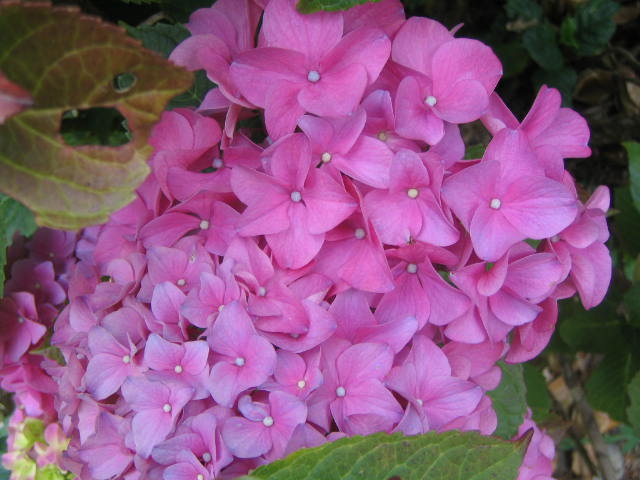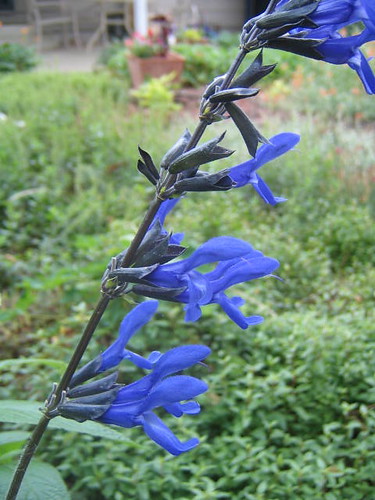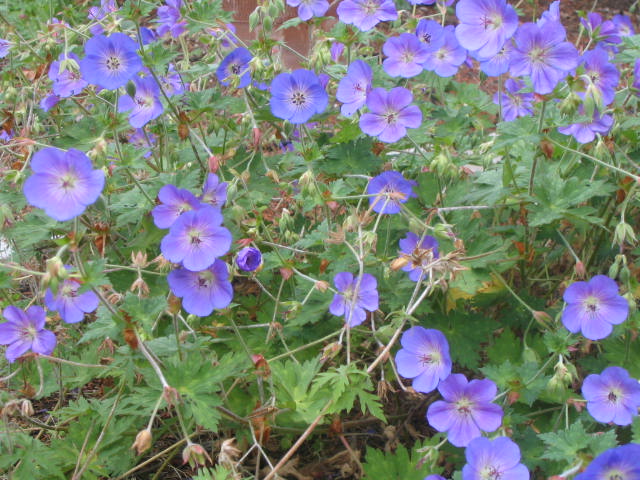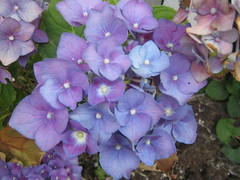Blue
When I was about eight years old, one of my friends told me that your favorite color had to be the color of your birthstone. I was born in September so that makes my birthstone a sapphire and my favorite color ever since has been blue. Talk about the power of suggestion!
I am, therefore, extremely gratified that I seem to be making headway in turning one of my hydrangeas from pink to blue. You can do that by tinkering with the soil pH. My tinkering took the form of scattering a few handfuls (how scientific!) of elemental sulphur around the drip line of the bush last fall and working it haphazardly into the soil.
I then let the winter rains work their magic. Better gardening through chemistry. I know people are always saying that you can change the pH of the soil “naturally” by adding coffee grounds, eggshells, or rusty nails to the soil. Bunk! If you want to change the pH you’ve got to resort to chemicals.
I’ve been wanting blue hydrangeas ever since I first saw them in England more than 20 years ago, but I had to wait until we moved to the hydrangea-friendly climate of Portland, Oregon. One of the big selling points of our house (for me) was that it had a big ol' hydrangea bush next to it. I am not kidding--it was in my top-ten reasons to buy the house. The only problem was that I’d have to turn the thing blue. It was resolutely pink. I read all up on how to turn hydrangeas blue. I’m really am not a fan of chemicals but I’m also really not a fan of pink. I finally settled on using sulphur to acidify the soil—supposedly less environmentally drastic than aluminum sulphate.
Well, I’m still trying to get that thing blue. The hydrangea pictured above is a newbie that I planted last year. The old established one looks like this.

Pinker than ever--despite last fall's sulphur treatment!!!! What’s really weird is that in past years it has been a fence straddler, putting out mainly lavenderish blooms--unwilling to commit fully to either pink or blue. This year the overall effect is definitely pink. I guess I am going to have to perhaps follow the directions on the sulphur container, which are not at all easy to fathom. It’s all about applying so many pounds per square foot. In other words, they want me to do math. There’s no math in gardening! Chemistry (of the mad scientist variety), yes. Math, no. Of course, I don’t want to kill the thing by oversulphuring it, so I’m not sure what to do next.
In the meantime, there are other blue flowers in my garden to enjoy.

Like this Salvia guaranitica 'Black and Blue'. Sqawking, electric-blue parrot beaks!

Rozanne RozannaRama!
Geranium ‘Rozanne’ has got to be the best blue perennial in horicultural existence. It’s a hardy geranium, and it blooms prolifically from spring til fall—supposedly. That's a lie. I’ve seen them blooming in my otherwise bleak garden on Christmas day. There are other blue hardy geraniums (‘Johnson’s Blue’ and ‘Brookside’), but ‘Rozanne’ beats the pants off them. Double Bonus: It does great in partial shade and thrives on neglect.
I could do with even more blue, though. Some people have what is known as “white gardens”—gardens in which all the flowers are white. I think Elton John has one—maintained by a paid lackey, no doubt. I can’t see Sir Elton pottering around with a watering can and a sack of steer manure, can you?
I, however, would totally be into an all-blue garden (and I would happily tote my own steer manure [or similar]). It’s a bit tricky, though, because so many of the so-called blues are, in fact, lavender ("blue" bellflowers, for example). Even the exalted ‘Rozanne’ goes a little purpley in hot weather. There are some great true blues, though, that I don’t have and should get: Love in a Mist, Bachelor Buttons, and a low-growing blue thing I don’t know the name of that actually blooms in fall—a virtue in and of itself. I’ve also tried to grow the fabulous steely blue sea holly (Eryngium 'Sapphire Blue'), but alas I planted it too close to the edge of the lawn, and it succumbed to the ding-dong Tulip Decapitator who always goes a little berserk with his edger.
A moment of silence, please.
I am, therefore, extremely gratified that I seem to be making headway in turning one of my hydrangeas from pink to blue. You can do that by tinkering with the soil pH. My tinkering took the form of scattering a few handfuls (how scientific!) of elemental sulphur around the drip line of the bush last fall and working it haphazardly into the soil.
I then let the winter rains work their magic. Better gardening through chemistry. I know people are always saying that you can change the pH of the soil “naturally” by adding coffee grounds, eggshells, or rusty nails to the soil. Bunk! If you want to change the pH you’ve got to resort to chemicals.
I’ve been wanting blue hydrangeas ever since I first saw them in England more than 20 years ago, but I had to wait until we moved to the hydrangea-friendly climate of Portland, Oregon. One of the big selling points of our house (for me) was that it had a big ol' hydrangea bush next to it. I am not kidding--it was in my top-ten reasons to buy the house. The only problem was that I’d have to turn the thing blue. It was resolutely pink. I read all up on how to turn hydrangeas blue. I’m really am not a fan of chemicals but I’m also really not a fan of pink. I finally settled on using sulphur to acidify the soil—supposedly less environmentally drastic than aluminum sulphate.
Well, I’m still trying to get that thing blue. The hydrangea pictured above is a newbie that I planted last year. The old established one looks like this.

Pinker than ever--despite last fall's sulphur treatment!!!! What’s really weird is that in past years it has been a fence straddler, putting out mainly lavenderish blooms--unwilling to commit fully to either pink or blue. This year the overall effect is definitely pink. I guess I am going to have to perhaps follow the directions on the sulphur container, which are not at all easy to fathom. It’s all about applying so many pounds per square foot. In other words, they want me to do math. There’s no math in gardening! Chemistry (of the mad scientist variety), yes. Math, no. Of course, I don’t want to kill the thing by oversulphuring it, so I’m not sure what to do next.
In the meantime, there are other blue flowers in my garden to enjoy.

Like this Salvia guaranitica 'Black and Blue'. Sqawking, electric-blue parrot beaks!

Rozanne RozannaRama!
Geranium ‘Rozanne’ has got to be the best blue perennial in horicultural existence. It’s a hardy geranium, and it blooms prolifically from spring til fall—supposedly. That's a lie. I’ve seen them blooming in my otherwise bleak garden on Christmas day. There are other blue hardy geraniums (‘Johnson’s Blue’ and ‘Brookside’), but ‘Rozanne’ beats the pants off them. Double Bonus: It does great in partial shade and thrives on neglect.
I could do with even more blue, though. Some people have what is known as “white gardens”—gardens in which all the flowers are white. I think Elton John has one—maintained by a paid lackey, no doubt. I can’t see Sir Elton pottering around with a watering can and a sack of steer manure, can you?
I, however, would totally be into an all-blue garden (and I would happily tote my own steer manure [or similar]). It’s a bit tricky, though, because so many of the so-called blues are, in fact, lavender ("blue" bellflowers, for example). Even the exalted ‘Rozanne’ goes a little purpley in hot weather. There are some great true blues, though, that I don’t have and should get: Love in a Mist, Bachelor Buttons, and a low-growing blue thing I don’t know the name of that actually blooms in fall—a virtue in and of itself. I’ve also tried to grow the fabulous steely blue sea holly (Eryngium 'Sapphire Blue'), but alas I planted it too close to the edge of the lawn, and it succumbed to the ding-dong Tulip Decapitator who always goes a little berserk with his edger.
A moment of silence, please.




0 Comments:
Post a Comment
<< Home